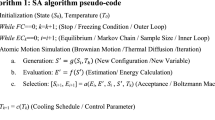Abstract
Random processes are increasingly becoming a topic of consideration in many areas where decision-making is an important factor. The random factor affects the difficulty of determining input parameters. The selection of these parameters can be a key element in achieving the correct results. Stochastic optimization methods can be used to solve this problem. In this article, the simulated annealing method was used to obtain an optimal solution, which then, in combination with the COMET method, provided satisfactory results by determining the relationship between the preferences of the initial alternatives and newly identified alternatives. The purpose of this study was to systematize the knowledge of effective selection of input parameters for stochastic methods. The obtained solution indicates how to select a grid to an unknown problem and how to select a step in the simulated annealing method to achieve more precise results.
Access this chapter
Tax calculation will be finalised at checkout
Purchases are for personal use only
Similar content being viewed by others
References
Adler, D.: Genetic algorithms and simulated annealing: a marriage proposal. In: IEEE International Conference on Neural Networks, pp. 1104–1109. IEEE (1993)
Boender, C.G.E., De Graan, J.G., Lootsma, F.A.: Multi-criteria decision analysis with fuzzy pairwise comparisons. Fuzzy Sets Syst. 29(2), 133–143 (1989)
Davis, L.: Genetic algorithms and simulated annealing (1987)
Deschrijver, G., Kerre, E.E.: On the relationship between some extensions of fuzzy set theory. Fuzzy Sets Syst. 133(2), 227–235 (2003)
Faizi, S., Sałabun, W., Rashid, T., Watróbski, J., Zafar, S.: Group decision-making for hesitant fuzzy sets based on characteristic objects method. Symmetry 9(8), 136 (2017)
Faizi, S., Rashid, T., Sałabun, W., Zafar, S., Watróbski, J.: Decision making with uncertainty using hesitant fuzzy sets. Int. J. Fuzzy Syst. 20(1), 93–103 (2018)
Guitouni, A., Martel, J.M.: Tentative guidelines to help choosing an appropriate MCDA method. Eur. J. Oper. Res. 109(2), 501–521 (1998)
Gupta, M.M., Qi, J.: Theory of T-norms and fuzzy inference methods. Fuzzy Sets Syst. 40(3), 431–450 (1991)
Kirkpatrick, S., Gelatt, C.D., Vecchi, M.P.: Optimization by simulated annealing. Science 220(4598), 671–680 (1983)
Kirkpatrick, S.: Optimization by simulated annealing: quantitative studies. J. Stat. Phys. 34(5–6), 975–986 (1984)
Van Laarhoven, P.J., Aarts, E.H., Lenstra, J.K.: Job shop scheduling by simulated annealing. Oper. Res. 40(1), 113–125 (1992)
Łokietek, T., Jaszczak, S., Nikończuk, P.: Optimization of control system for modified configuration of a refrigeration unit. Procedia Comput. Sci. 159, 2522–2532 (2019)
Nikończuk, P.: Preliminary modeling of overspray particles sedimentation at heat recovery unit in spray booth. Eksploatacja i Niezawodność 20, 387–393 (2018)
Piegat, A.: Fuzzy Modeling and Control (Studies in Fuzziness and Soft Computing). Physica 742 (2001)
Piegat, A., Sałabun, W.: Nonlinearity of human multi-criteria in decision-making. J. Theor. Appl. Comput. Sci. 6(3), 36–49 (2012)
Roubens, M.: Fuzzy sets and decision analysis. Fuzzy Sets Syst. 90(2), 199–206 (1997)
Sałabun, W.: The characteristic objects method: a new distance-based approach to multicriteria decision-making problems. J. Multi-Criteria Decis. Anal. 22(1–2), 37–50 (2015)
Sałabun, W., Karczmarczyk, A., Watróbski, J.: Decision-making using the hesitant fuzzy sets COMET method: an empirical study of the electric city buses selection. In: 2018 IEEE Symposium Series on Computational Intelligence (SSCI), pp. 1485–1492. IEEE (2018)
Sałabun, W., Palczewski, K., Watróbski, J.: Multicriteria approach to sustainable transport evaluation under incomplete knowledge: electric bikes case study. Sustainability 11(12), 3314 (2019)
Sałabun, W., Piegat, A.: Comparative analysis of MCDM methods for the assessment of mortality in patients with acute coronary syndrome. Artif. Intell. Rev. 48(4), 557–571 (2017)
Watróbski, J., Jankowski, J.: Knowledge management in MCDA domain. In: 2015 Federated Conference on Computer Science and Information Systems (FedCSIS), pp. 1445–1450. IEEE (2015)
Watróbski, J., Jankowski, J., Ziemba, P., Karczmarczyk, A., Zioło, M.: Generalised framework for multi-criteria method selection. Omega 86, 107–124 (2019)
Wątróbski, J., Sałabun, W.: The characteristic objects method: a new intelligent decision support tool for sustainable manufacturing. In: International Conference on Sustainable Design and Manufacturing, pp. 349–359. Springer, Cham (2016)
Watróbski, J., Sałabun, W.: Green supplier selection framework based on multi-criteria decision-analysis approach. In: International Conference on Sustainable Design and Manufacturing, pp. 361–371. Springer, Cham (2016)
Watróbski, J., Sałabun, W., Karczmarczyk, A., Wolski, W.: Sustainable decision-making using the COMET method: an empirical study of the ammonium nitrate transport management. In: 2017 Federated Conference on Computer Science and Information Systems (FedCSIS), pp. 949–958. IEEE (2017)
Zadeh, L.A.: Information and control. Fuzzy Sets 8(3), 338–353 (1965)
Zimmermann, H.J.: Fuzzy Set Theory and its Applications. Springer Science & Business Media (2011)
Acknowledgements
The work was supported by the National Science Centre, Decision No. DEC-2016/23/N/HS4/01931.
Author information
Authors and Affiliations
Corresponding author
Editor information
Editors and Affiliations
Rights and permissions
Copyright information
© 2020 The Editor(s) (if applicable) and The Author(s), under exclusive license to Springer Nature Singapore Pte Ltd.
About this paper
Cite this paper
Więckowski, J., Kizielewicz, B., Kołodziejczyk, J. (2020). Finding an Approximate Global Optimum of Characteristic Objects Preferences by Using Simulated Annealing. In: Czarnowski, I., Howlett, R., Jain, L. (eds) Intelligent Decision Technologies. IDT 2020. Smart Innovation, Systems and Technologies, vol 193. Springer, Singapore. https://doi.org/10.1007/978-981-15-5925-9_31
Download citation
DOI: https://doi.org/10.1007/978-981-15-5925-9_31
Published:
Publisher Name: Springer, Singapore
Print ISBN: 978-981-15-5924-2
Online ISBN: 978-981-15-5925-9
eBook Packages: Intelligent Technologies and RoboticsIntelligent Technologies and Robotics (R0)




